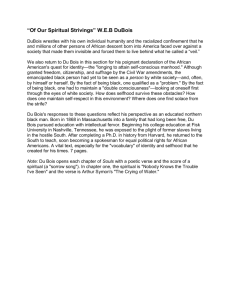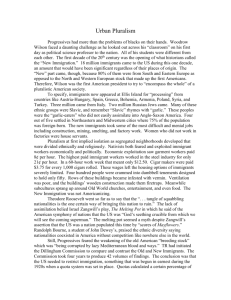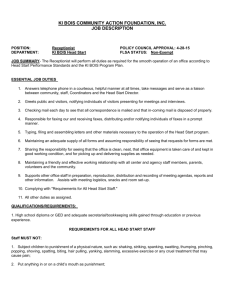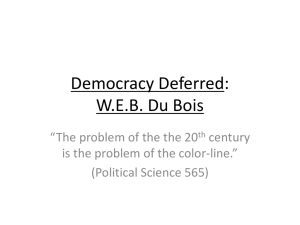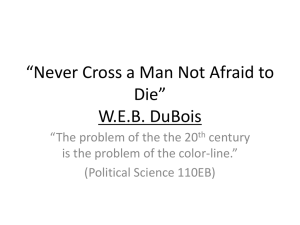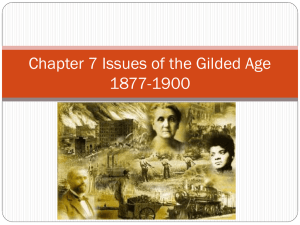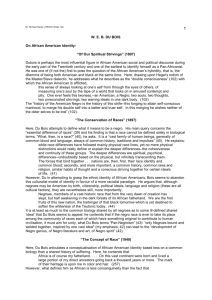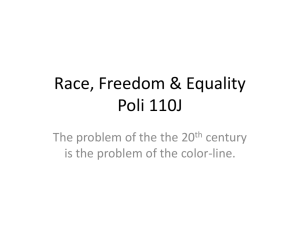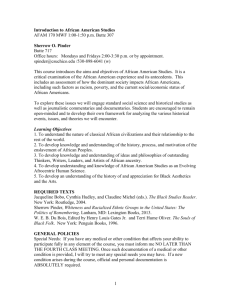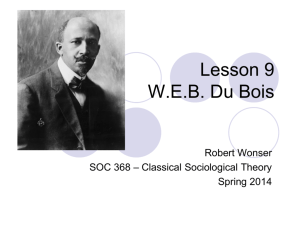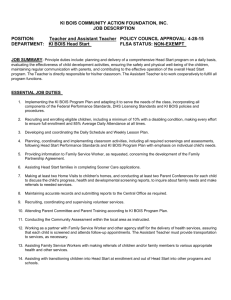W.E.B. Du Bois - SOC 331: Foundations of Sociological Theory
advertisement
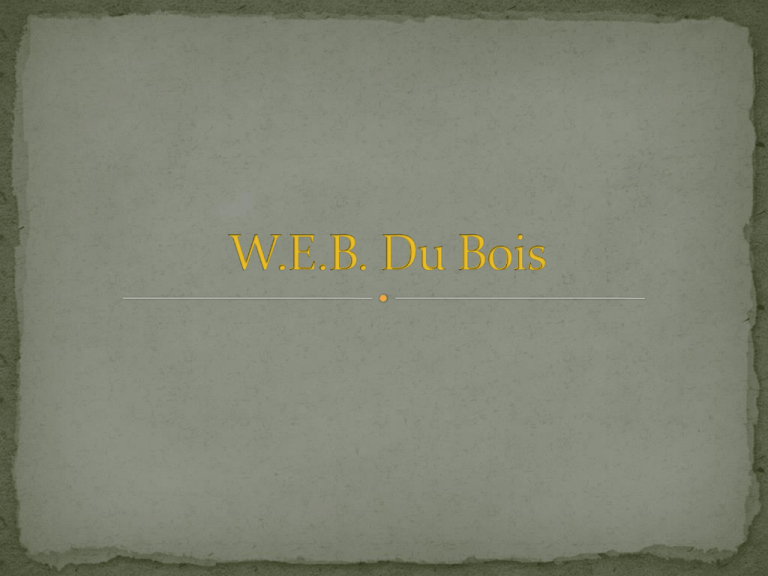
2 Historical – for exposing intellectual and political schism in the black community, between moderates such as Booker T. Washington and more radical Du Bois accommodation vs agitation Social scientific – features a new “voice,” more “soulful” than detached Facts alone not enough to motivate change Theoretical – for introducing interrelated concepts of the color line, double consciousness and the veil 3 The color line is multidimensional, manifesting as: “racialized social institutions” (e.g., Jim Crow laws) “symbolic status hierarchy” “internalized attitude” [See Fig. 7.2, p. 337.] Nonrational Color line (internalized attitude) A C T I O N Color line (symbolic status hierarchy) Collective Individual ORDER Color line (racialized social institutions) Rational 5 Racialized social institutions: colonialism, slavery, Jim Crow laws, redlining, ‘SAT’ (standardized testing regime more broadly), the War on Drugs, i.e., drug policy/policing/sentencing ‘differential punishment’ e.g., harsher penalties for possession/distribution of ‘crack’ vs. (more expensive) ‘powder’ cocaine, which is more likely to be used by whites It begins with colonialism: “Once the color line began to pay dividends” through the colonization and exploitation of Africa and Africans beginning in the 15th century, race became central to world history Africa’s poverty is inexorably linked to colonialism and imperial domination – wealth of the colonial empires of England, France, Germany and the U.S. “comes directly from the darker races of the world” 6 Double consciousness manifests in: the power of white stereotypes on black life and thought (dealing with the misrepresentation of one's own people while also having the knowledge of reflexive truth) the racism that excluded black Americans from the mainstream of society, being American or not American most significantly, the internal conflict between being African and American simultaneously 7 GHM’s theory suggests that white racism, the ‘white gaze,’ has consequences for the ‘self’ development of blacks We attain selves through a developmental process Each individual learns to see herself as a distinct person, but only insofar as other responds to that individual as an individual In other words: we come to see ourselves as distinct because others see us as distinct 8 Parallels Simmel’s discussion of The Stranger Both Simmel & Du Bois employ “veil” metaphor, to convey the sense of separateness among people in modern society The notion of double consciousness can be applied to a range of other social categories considered “other” women, minorities of all kinds, the undocumented, the disabled, and so on 9 Like Du Bois, Cooper emphasized giving “voice” to submerged points of view Argues that categories such as race, gender, and class do not capture, by themselves, the situation of black women The black woman “is confronted by both a woman question and a race problem” Views higher education as the key to ending women’s physical, emotional, and economic dependence on men Sided w/Du Bois et al. in the debate on strategies for black empowerment and equality 10 “After the Egyptian and Indian, the Greek and Roman, the Teuton and Mongolian, the Negro is a sort of seventh son, born with a veil, and gifted with second-sight in this American world,--a world which yields him no selfconsciousness, but only lets him see himself through the revelation of the other world. It is a peculiar sensation, this double-consciousness, this sense of always looking at one's self through the eyes of others, of measuring one's soul by the tape of a world that looks on in amused contempt and pity. One ever feels his two-ness,--an American, a Negro; two souls, two thoughts, two unreconciled strivings; two warring ideals in one dark body, whose dogged strength alone keeps it from being torn asunder.” 11 Nationally Publicized “White Gaze” I couldn’t help but think of Fanon’s discussion of the “white gaze” and Du Bois’ discussion of “double-consciousness” while watching the Obama speech. Indeed, for most of the speech he seemed to be defending himself–not only for his pastor’s actions–but for his very existence as a black (and really biracial) man in America. Particularly in the beginning to middle segments of the speech, I felt his approach mirrored Du Bois’ travels within the “veil”. Indeed, Obama offered a sort of apologetic narrative of blacks’ experiences, struggles, and history in America. None of these stories would be particularly new for most blacks, but I suspect he was attempting to reveal the psyche and mindset of blacks to a white audience. Also like Souls of Black Folk, it was a speech about blacks for whites–not necessarily for other black people… 12 Nationally Publicized “White Gaze” (cont’d) …I was also intrigued by the way in which race, religion, and nation were so closely tied together in his speech. The only thing he seemed to spend more time speaking about than his race was his church. Here the “white gaze” seemed particularly prominent to me, for–once again–he had to offer an apology for the merits of the black church. Finally, it is interesting to me that Obama even considers himself and is labeled as “black” when he is in fact bi-racial. What does it say about society that there is no room for ambiguity here, but that we still today follow a sort of “one drop” rule? Further, it reminded me of the problem of the mulatto in Douglass’ and Jacobs’ slave narratives. For the mulatto points to the flaws in the racial logic and categories. And, indeed, instead of embracing Obama’s multiculturalness, we as a society have pigeon-holed him into one neat racial category. [emphasis added] 13 Recent books by Michelle Alexander (The New Jim Crow: Mass Incarceration in the Age of Colorblindness, 2010) and Douglas Blackmon (Slavery by Another Name, 2008) argue mass incarceration of blacks today is parallel to enslavement and peonage laws, a new ‘Jim Crow’ racialized social institution In A Plague of Prisons: The Epidemiology of Mass Incarceration in America, Ernest Drucker (CUNY-John Jay) likens mass incarceration to an epidemic and advocates a ‘public health’ approach to the problem 14 Today there are more African Americans under correctional control than there were enslaved in 1850 1 in 3 young African American men will serve time in prison if current trends continue, in some cities more than half of all young adult black men are currently under correctional control (Alexander, p. 9) As of 2004, more African American men were disenfranchised (due to felon disenfranchisement laws) than in 1870, the year the 15th Amendment was ratified, prohibiting laws that explicitly deny the right to vote on the basis of race 15 In 2011, 685,724 New Yorkers were stopped by the police, a 603% increase since the program began in 2002 In 2002, stops totaled 97,296 Of those stopped for street searches, nearly 9 out of 10 were completely innocent (neither arrested nor issued summons) 87% were black or Latino 350,743 black (53 %), 223,740 Latino (34 %), 61,805 white (9 %) 16 Type of stratification resembles caste, which Weber conceptualized as status distinctions that become embedded in institutions, law, policy This vast new racial undercaste — and I say “caste”, not “class,” because this is a population which is locked into an inferior status by law and by policy — this vast population has been rendered largely invisible through affirmative action and the appearance of success with, you know, a handful of African Americans doing well in universities and corporations… Young men of color, in particular, are labeled as felons, labeled as criminals, at very young ages, often before they even reach voting age, before they turn eighteen. Their backpacks are searched. They’re frisked on the way to school, while standing waiting for the school bus to arrive. Once they learn to drive, their cars are searched, often dismantled in a search for drugs. The drug war waged in these poor communities of color has created generations of black and brown people who have been branded felons and relegated to a permanent second-class status for life. 17 AMENDMENT XIII Section 1. Neither slavery nor involuntary servitude, except as a punishment for crime whereof the party shall have been duly convicted, shall exist within the United States, or any place subject to their jurisdiction. [emphasis added] Section 2. Congress shall have power to enforce this article by appropriate legislation. Passed by Congress January 31, 1865. Ratified December 6, 1865. Note: A portion of Article IV, section 2, of the Constitution was superseded by the 13th amendment. 18 Status groups may evolve into closed castes Status distinctions may be guaranteed not merely by conventions and laws, but also by religious sanctions Evolution of status to caste is more likely when underlying differences are considered "ethnic“ Ethnic segregation grown into a caste transforms horizontal and unconnected coexistences of ethnically segregated groups into a vertical social system of domination & subordination Remember: Ethnic communities are based on a belief of commonality rather than any objective “racial differences” Relationship between ethnicity/race & social status is variable Undocumented immigrants might also be considered an “undercaste,” 19 as lack of legal status leaves them without basic rights and protections Du Bois and Washington were on opposite sides of critical political & intellectual debates within the black community, debates that continue, in some form, today Du Bois was radical, Washington, moderate Washington promoted the Atlanta Compromise, a conciliatory approach toward southern white supremacy, whereas Du Bois favored confrontation Washington promoted industrial education in trades for blacks, whereas Du Bois viewed higher education, at least for the ‘Talented Tenth,’ as critical for the advancement of all black people Talented Tenth would be the “vanguard” 20 From Dark Water: Voices from Within the Veil by W.E.B. Du Bois 21 A more radical critique than The Souls of Black Folk “The Souls of White Folk” focuses on the political economy of race, racism, whiteness, and white supremacy white supremacy is an ideology that shapes institutions, both national and international It underpins Western imperialism and the global ‘status hierarchy’ of nation-states 22 The using of men for the benefit of masters is no new invention of modern Europe. It is quite as old as the world. But Europe proposed to apply it on a scale and with an elaborateness of detail of which no former world ever dreamed. The imperial width of the thing,—the heavendefying audacity—makes its modern newness. (368) 23 Whither is this expansion?...How many of us today fully realize the current theory of colonial expansion, of the relation of Europe which is white, to the world which is black and brown and yellow? Bluntly put, that theory is this: It is the duty of white Europe to divide up the darker world and administer it for Europe's good. (368) Colonial conquest as ‘White Man’s Burden’ 24 The scheme of Europe was no sudden invention, but a way out of long-pressing difficulties. It is plain to modern white civilization that the subjection of the white working classes cannot much longer be maintained. Education, political power, and increased knowledge of the technique and meaning of the industrial process are destined to make a more and more equitable distribution of wealth in the near future. The day of the very rich is drawing to a close, so far as individual white nations are concerned. But there is a loophole. There is a chance for exploitation on an immense scale for inordinate profit, not simply to the very rich, but to the middle class and to the laborers. This chance lies in the exploitation of darker peoples. It is here that the golden hand beckons. Here are no labor unions or votes or questioning onlookers or inconvenient consciences. These men may be used down to the very bone, and shot and maimed in "punitive" expeditions when they revolt. In these dark lands "industrial development" may repeat in exaggerated form every horror of the industrial history of Europe, from slavery and rape to disease and maiming, with only one test of success,—dividends! (368-9) 25 This theory of human culture and its aims has worked itself through warp and woof of our daily thought with a thoroughness that few realize. Everything great, good, efficient, fair, and honorable is "white"; everything mean, bad, blundering, cheating, and dishonorable is "yellow"; a bad taste is "brown"; and the devil is "black." The changes of this theme are continually rung in picture and story, in newspaper heading and movingpicture, in sermon and school book, until, of course, the King can do no wrong,—a White Man is always right and a Black Man has no rights which a white man is bound to respect. (369) 26 The cause of war is preparation for war; and of all that Europe has done in a century there is nothing that has equaled in energy, thought, and time her preparation for wholesale murder. The only adequate cause of this preparation was conquest and conquest, not in Europe, but primarily among the darker peoples of Asia and Africa; conquest, not for assimilation and uplift, but for commerce and degradation. For this, and this mainly, did Europe gird herself at frightful cost for war. (bottom, 369) 27 Walter Benn Michaels, author of The Trouble with Diversity: How We Learned to Love Identity and Ignore Inequality argues contemporary conceptions of justice focus on gaining respect for difference, different social identities, rather than reducing economic inequality Today, there are more differences between rich and poor than black and white “Affirmative action is a policy designed to make rich, white people feel better about themselves” a policy designed “to make sure the rich kids come in different colors” The crisis of education begins long before college, at the K-12 level Race is not the fundamental problem in US society It’s money and lack of money Poor people don’t want your respect, they want your money As far as money goes less, not more, diversity is what we want 28 In Disintegration: The Splintering of Black America (2010), Eugene Robinson, sorts modern American blacks into 4 categories: 1) Transcendants: wealthy blacks, composed chiefly of athletes, singers and media darlings 2) Abandoned: a "large minority" of African Americans that sociologists used to call the “underclass” in the 1980s 3) Emergents: people who are biracial, children of parents from Africa or the African diaspora, or, like Obama, both 4) Black mainstream: a "middle-class majority with a full ownership stake in American society" 29
